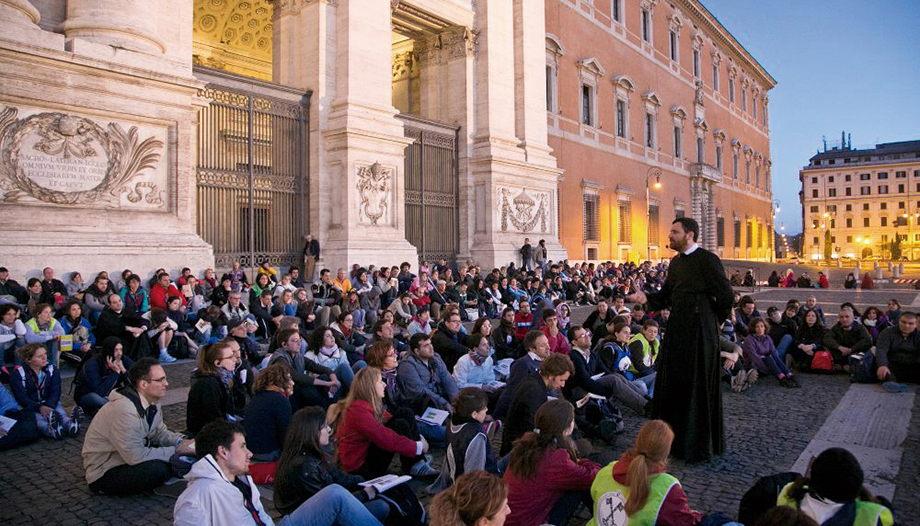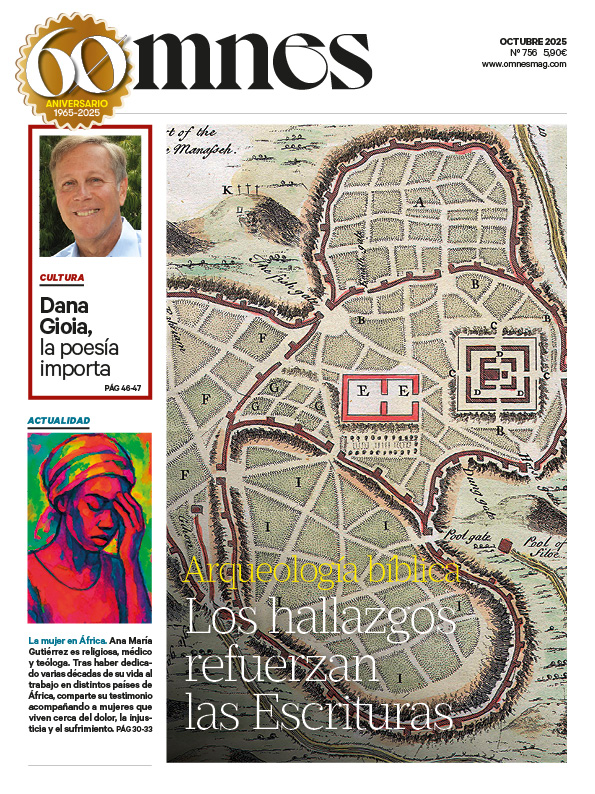One Friday evening, a priest friend of mine who was in Rome, was walking along the Corso Vittorio Emmanuele and crossing in front of a church he was surprised to see it open at an unusual hour. Along the street abounded groups of young people looking for the bars, arranged to spend the night in any place that offered them fun. However, he found to his astonishment that many of them were not approaching the drinking establishments that abounded in that neighborhood, with the lure of their music and the noise of their conversations. They were going to the temple, which also opened its doors to the city, to a world controlled by the planners of welfare, which obstinately turns its back on God. It is the young proposal of a young Church.
Those boys and girls who entered the church did not do so with the feeling that they were wasting their time, or wasting their leisure hours. They were determined to pray, convinced that they were really enjoying the evening, in a place where there were no drinks on offer and no fashionable songs to be heard. There he met hundreds of people, seated on the benches and on the floor, who listened in silence and with unusual attention to the words of a priest. He was speaking to them from a text of the Bible, and his words were not the telling of an ancient story, but something living, part of the history of those who listened to him. There paraded the yearnings of a young heart, its hopes, its anxieties, its illusions... and all these questions found an answer in the life of a person: Jesus Christ.
More and more parishes are repeating meetings like the one described above, adapted to a young audience, which attract attention because of their unusual time, the place where they are held, or the methodology they use. One of them is the one developed by the Congregation of the Oratory of St. Philip Neri, in the parish of Santa Maria in Vallicella in Rome.
Pilgrimage to the seven churches
One of St. Philip Neri's proposals consists of a pilgrimage to some of the holy places in the city of Rome. From the church of St. Jerome were headed to San Pedro to pray at the tomb of the first pope. Then they attended to the sick in a hospital and then they went to Santa María la Mayor, where they used to stop also to take food and regain strength before tackling the next stages of their pilgrimage: the basilica of St. Paul and the catacombs of St. Sebastian. After celebrating mass, they set out on their return journey, visiting the basilicas of St. John Lateran and the Holy Cross in Jerusalem. To the road was added a visit to San Lorenzoto end with the recitation of the Salve once again in the basilica of Santa Maria Maggiore.
A Roman tour that its participants began to familiarly call "visits", as is done between friends who come to a house to engage in conversation or bring a gift. The difference was that here the houses visited corresponded to places linked to the Christian memory of the city of Rome. What began in 1551 as a familiar proposal of St. Philip Neri to his group of companions, was acquiring popularity, so that in a few years the participants in these "visits" reached thousands of people. In fact, it was a revival of the ancient medieval tradition of the pilgrimage to the tombs of Peter and Paul, and two days were used to extend the tour to "the seven churches".
Today this pilgrimage continues to attract the faithful, especially young people, because it is a demanding journey of 25 kilometers and about 12 hours of walking. It starts at 7:30 in the evening, after mass at the church of Santa Maria de Vallicella and at dawn you arrive at Santa Maria the Major. There the pilgrims are divided into groups to facilitate the atmosphere of conviviality and prayer. Maurizio's words, and to pray the Rosary. Testimonies are also shared, such as that of Luisa, who after finishing her engineering studies discovered the call to religious life and speaks with gratitude of her experience of surrender to God. Gianfranco, who has been married for a few years, tells how he has felt the help of grace in coping with the daily setbacks that arise in his marriage.
The contrast with the other young people who walk through the same city in search of artificial paradises is strong, and makes the missionary enthusiasm of the pilgrims grow. Termini At 7 a.m. the next morning, they break into singing the Salve with fatigue on their faces and the joy of having completed their pilgrimage in sight of the Basilica of Santa Maria Maggiore. As one of the participants explains, it is "an exhausting, but very beautiful experience"..
The five steps of the mystery
In continuity with the oratorian tradition of preaching, the church in Santa Maria in Vallicella offers a way of community prayer around very well prepared sermons or talks. They are priests in talar attire who follow the style of St. Philip Neri of positively evaluating the cultural tendencies of their time, and of going to the sources of Sacred Scripture and Tradition. They are not friends of abstractions, but like to use historical arguments: they delve into the events and vicissitudes of the Church in other epochs, in order to also confront current aspects of civil and social life in the light of faith. Among other issues, topics such as immigration in Europe or family laws have recently been discussed.
One of these initiatives is the one that Father Maurizio Bottalleva has been successfully carrying out for the last 7 years, and it aims to introduce the faithful to the heart of the Christian mystery through monthly meetings that are presented as The five steps to the Mystery. The mystery spoken of is not an enigma, but something that presents itself to us and challenges us, like life itself. The very words of the five steps are eloquent: the desert, consolation, thirst, night and death. With them we arrive at the center of the mystery, which is shown to those who decide to listen to the word of Jesus Christ and lead a life according to his will.
These steps are intended to show that believing in God and in his Church is reasonable. St. Philip Neri tried to do the same at the dawn of the modern age, when many considered the believing perspective to be outdated by opposing it to rational knowledge. However, as Pope Emeritus Benedict XVI has reminded us, faith and reason are not opposed to each other, and the knowledge of the believer does not diminish our vital horizon, but enlarges it, broadens it and widens it to reach a knowledge that goes beyond mere sensible experience. In these meetings we also want to reach out to those who have no faith because they lack religious formation, or because they have lost the faith they stopped practicing. In an atmosphere of prayer, the meetings are held in a flexible but orderly way: they begin with a half-hour sermon in which the theme is presented. This is followed by another half hour to answer questions that are asked anonymously on papers that are collected after the presentation. The meeting is concluded, but after a brief pause, those who wish may remain for another half hour of fraternal dialogue.
As can be seen, the rich tradition of the Church continues to offer answers to the various challenges facing society today. The Oratorian method introduces us to a climate of sincere friendship and prayer that is at the same time simple and profound. As Pope Francis said in his message on the occasion of the 500th anniversary of the birth of St. Philip Neri, his spirituality remains a model for the Church's ongoing mission in the world, especially his ability to be a person who prays and who makes people pray. His deep conviction, says the Pope in that message, was that the path to holiness is founded on the grace of an encounter (with the Lord), accessible to anyone, of any state and condition, who welcomes him with the wonder of children.







